
CPR stands for cardiopulmonary resuscitation, and is the method used to give someone a better chance at survival after they suffer a cardiac arrest. It is important to know what the guidelines are for performing this procedure wherever you are based.
What is CPR?
Cardiopulmonary resuscitation, or CPR, is a potentially lifesaving procedure that is performed by manually oxygenating and pumping the casualty’s blood to preserve brain function.

How to perform CPR
- Shout for help, while gently shaking the person and finding out if they are responsive and breathing normally.
- If they are not responding or breathing normally, call 999. Have the phone on speaker so that you can listen and talk while performing the procedure.
- Start compressions. If possible, ensure that the casualty is on a firm, flat surface before beginning.
- If you are trained, after 30 compressions, give two rescue breaths before continuing the chest compressions.
- If there is an AED nearby, get someone to fetch it for you, do not leave the patient yourself to do this. When it arrives follow the instructions.
- Continue with CPR until:
- Emergency services arrive.
- The AED tells you to stop.
- You are unable to continue due to exhaustion.
- You are in immediate danger.
- The person starts breathing normally.
What are CPR laws in the UK?
There are no specific laws around CPR in the UK currently.
However, there is a “duty of care”, even if you are not a healthcare professional, if you were to aid someone who has collapsed, then it is important for you to assist that person as much as you are able. If you do not do this once you have begun administering CPR, you could set yourself up for a liability lawsuit.
You would only be legally liable for prosecution, if the person with the lawsuit could prove that they would have been better off without your intervention, which is very unlikely.

CPR guidelines in the UK
According to the Resuscitation Council UK, there are a few guidelines that should be followed when providing adult basic life support.
- You are to start CPR on anyone who is found unresponsive with absent or abnormal breathing.
- If the person has slow and laboured breathing, then that is to count as a sign of cardiac arrest.
- You must immediately alert the emergency services and leave the call on speaker, either by dialling 999 yourself or having a bystander do it.
- Start chest compressions immediately.
- Perform CPR on a firm, flat surface where possible.
- Compress the chest 5-6cm.
- Compressions should be 30 at a time at a rate of 100-120 a minute.
- Do not lean on the chest – allow it to come back up after each compression.
- Only perform rescue breaths if trained.
- 2 breaths after 30 compressions.
- Do not take longer than 10 seconds between the compressions for these.
Guidelines for AEDs in the UK
An AED, automated external defibrillator, is a machine that delivers shocks to a casualty that has suffered a cardiac arrest. There is no legal requirement for places to have one on their premises, but most locations do have one accessible.
There are a few guidelines on their use in conjunction with CPR, such as:
- Switch the AED on as soon as it is available, if there is one present.
- Follow the instructions to attach the pads to the person’s bare chest.
- If there are multiple people present, continue CPR while this is being set up.
- Ensure that no one is touching the person while the AED is checking/shocking the casualty.
- Immediately restart CPR after a shock has been administered.
For more information on AEDs and the laws around them you can visit these blogs:
Or, we have a training course available on AEDs.

Why is it important to know CPR and the guidelines around it?
CPR could be the difference between life and death for someone. This is because brain cells will start to shut down if they are deprived of oxygen for too long (generally around 4-6 minutes), so by keeping the oxygen flowing to the brain until emergency services are on the scene it will increase the likelihood of that person surviving.
Knowing the guidelines around CPR if you are able to perform it, is important because it shows you have an understanding of the procedure. It will ensure that no mistakes are made when caring for a casualty and will reduce the risk of harming the person further.
Read our other blogs for more information on first aid or contact us for further advice and information on our courses.
